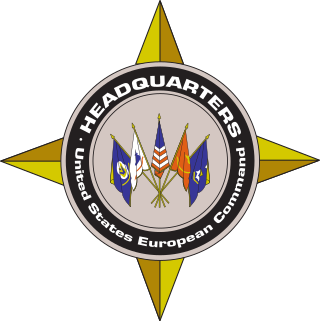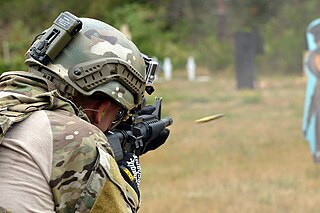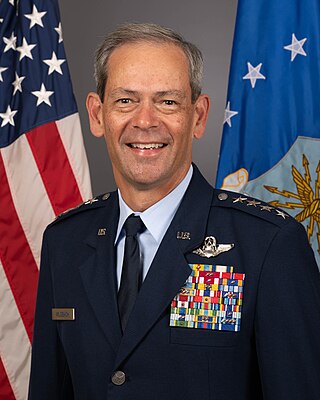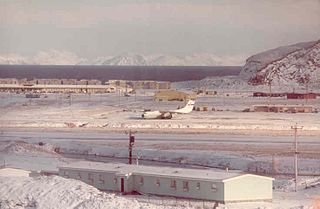
The United States Indo-Pacific Command (USINDOPACOM) is the unified combatant command of the United States Armed Forces responsible for the Indo-Pacific region.

The Pacific Air Forces (PACAF) is a Major Command (MAJCOM) of the United States Air Force and is also the air component command of the United States Indo-Pacific Command (USINDOPACOM). PACAF is headquartered at the Hickam AFB portion of Joint Base Pearl Harbor–Hickam, Hawaii, and is one of two USAF MAJCOMs assigned outside the Continental United States, the other being the United States Air Forces in Europe – Air Forces Africa. Over the past sixty-five plus years, PACAF has been engaged in combat during the Korean and Vietnam Wars and Operations Desert Storm, Southern Watch, Northern Watch, Enduring Freedom and Iraqi Freedom.

The United States European Command (EUCOM) is one of the eleven unified combatant commands of the United States military, headquartered in Stuttgart, Germany. Its area of focus covers 21,000,000 square miles (54,000,000 km2) and 51 countries and territories, including Europe, The Caucasus, Russia and Greenland. The Commander of the United States EUCOM simultaneously serves as the Supreme Allied Commander, Europe (SACEUR) within NATO, a military alliance. During the Gulf War and Operation Northern Watch, EUCOM controlled the forces flying from Incirlik Air Base.

The Eleventh Air Force (11 AF) is a Numbered Air Force of the United States Air Force Pacific Air Forces (PACAF). It is headquartered at Joint Base Elmendorf–Richardson, Alaska.

The Alaskan Air Command (AAC) is an inactive United States Air Force Major Command originally established in 1942 under the United States Army Air Forces. Its mission was to organize and administer the air defense system of Alaska, exercise direct control of all active measures, and coordinate all passive means of air defense. In addition, the command also supported Strategic Air Command elements operating through and around Alaska. It was redesignated Eleventh Air Force on 9 August 1990 and, concurrently, status changed from a major command of the United States Air Force to a subordinate organization of Pacific Air Forces.

Fort Richardson is a United States Army installation in the U.S. State of Alaska, adjacent to the city of Anchorage. In 2010, it was merged with nearby Elmendorf Air Force Base to form Joint Base Elmendorf-Richardson.

The Alaska Air National Guard (AK ANG) is the aerial militia of the State of Alaska, United States of America. It is, along with the Alaska Army National Guard, an element of the Alaska National Guard.

The 18th Fighter Interceptor Squadron is a subordinate unit of the 354th Fighter Wing based at Eielson Air Force Base in Alaska, and flies the Block 30 General Dynamics F-16C/D aircraft.

Carrol Howard "Howie" Chandler, is a retired United States Air Force four-star general. He last served as the 35th Vice Chief of Staff of the Air Force from August 27, 2009, to January 14, 2011. He previously served as commander of Pacific Air Forces from November 2007 to August 20, 2009, and deputy chief of staff for operations, plans and requirements from October 23, 2005, to November 29, 2007. As vice chief, he presided over the Air Staff and served as a member of the Joint Chiefs of Staff Requirements Oversight Council and Deputy Advisory Working Group. He assisted the chief of staff with organizing, training, and equipping of 680,000 active-duty, Guard, Reserve and civilian forces serving in the United States and overseas. He retired from the Air Force by March 1, 2011. In 2012 he joined Pratt & Whitney Military Engines as vice president for military business development and international programs.

Exercise Northern Edge is a military joint training exercise conducted by the United States Armed Forces in the Gulf of Alaska. Alaskan Command (ALCOM) uses expansive Alaskan training ranges to conduct this joint training operation.

Minneapolis–Saint Paul Joint Air Reserve Station is a United States Air Force base, located at Minneapolis–Saint Paul International Airport. It is located in the Fort Snelling Unorganized Territory on the southeast border of Minneapolis, Minnesota. It was formerly the location of Naval Air Station Twin Cities.

Douglas Malcolm Fraser, is a United States Air Force (USAF) general who served as the Commander, United States Southern Command (USSOUTHCOM). He was the first USAF officer to become USSOUTHCOM's combatant commander. He previously served as Deputy Commander, United States Pacific Command from April 2008 to June 24, 2009. He assumed his final assignment on June 25, 2009.

The 3rd Air Support Operations Squadron is a combat support unit of the United States Air Force, located at Fort Wainwright, Alaska.

The United States Army Alaska was a military command of the United States Army located in the U.S. state of Alaska. A subordinate command of I Corps, USARAK was the ground element of the Alaskan Command. USARAK was headquartered at Joint Base Elmendorf-Richardson and commanded by a major general. USARAK was reflagged as the 11th Airborne Division on June 6, 2022.

Kenneth Stephen Wilsbach is a United States Air Force general who serves as the commander of Air Combat Command. He previously served as the commander of Pacific Air Forces from 2020 to 2024.

Elmendorf Air Force Base is a United States Air Force (USAF) facility in Anchorage, Alaska. Originally known as Elmendorf Field, it became Elmendorf Air Force Base after World War II.

Naval Air Facility Adak, was a United States Navy airport located west of Adak, on Adak Island in the U.S. state of Alaska. After its closure in 1997, it was reopened as Adak Airport. The facility was designated a National Historic Landmark for its role in World War II, although most of its elements from that period have been demolished or lie in ruins.

Joint Base Elmendorf–Richardson is a United States military facility in Anchorage, Alaska. It is a joint base formed from the United States Air Force's Elmendorf Air Force Base and the United States Army's Fort Richardson, which were merged in 2010.

Tod Daniel Wolters is a retired United States Air Force four-star general who last served as the commander of U.S. European Command and concurrently as NATO's Supreme Allied Commander Europe (SACEUR). He previously served as the commander of U.S. Air Forces in Europe and U.S. Air Forces Africa. He assumed his capstone assignment at the European Command in Germany on May 2, 2019 and at the Allied Command in Belgium on May 3, 2019.




















